Moran Lake Water Quality Study & Conceptual Restoration Plan
Restoration opportunities exist in the Moran Lake watershed to improve water quality and habitat conditions in the lagoon.Many opportunities are present in the immediate vicinity of the lagoon, while other projects and actions can be taken in the upper watershed area.
Restoration options presented below include a broad spectrum of activities, including physical restoration projects, storm water management and treatment, recommendations for environmental education, site planning and design standards with the objective of reducing impervious cover in the watershed.
5.1. Lagoon Restoration and Education Opportunities
This section identifies restoration and environmental education projects that could be implemented in the immediate vicinity of the lagoon.
5.1.1 Improve Lagoon Water Circulation
Historical and ongoing water quality testing clearly indicates that lack of circulation and infrequent flushing of the lagoon with fresh and/or salt water is impairing water quality and aquatic life in the lagoon.As previously discussed many factors affect circulation, mixing and the occurrence of freshwater and tidal flushing in the lagoon.In review, these factors include the freshwater inflows, lagoon volume, frequency (how often) and duration (how long) the lagoon remains open or closed.Many of these factors are random or commonly referred to as stochastic variables that can vary both seasonally and annually depending on many conditions.
To improve circulation in the lagoon several different approaches could potentially be taken, such as, modifying the inlet to attempt to increase tidal and stream flushing, enlarging and deepening the lagoon to near its original size, actively managing the lagoon entrance (breaching the sand bar and removing sediments in culvert), installing an aeration system to increase biological decomposition of detritus and maintain higher levels of dissolved oxygen in the water column, and possibly augmenting stream flow with highly treated reclaimed wastewater.In all cases a more detailed technical and economic analysis would be required to assess the overall technical feasibility and benefit derived from the various alternatives.The following sections provide a brief summary of potential merits or constraints related to each alternative.
Modify Lagoon InletAs previously discussed a significant concern is that the lagoon inlet may limit the opening and closing of the inlet, and reduce circulation and tidal flushing of the lagoon resulting in degraded water quality and aquatic habitat conditions.The existing box culvert, an engineered structure, fixes the position, cross-sectional area, and depth or grade of the inlet channel.In a natural lagoon system the inlet is in a state of dynamic equilibrium, meaning that the inlet configuration (location, cross-sectional area and depth) responds primarily to seasonal variations in the water flow, water levels, littoral drift, and wave action.The culvert and roadbed have "stabilized" the lagoon inlet preventing the natural migration of the inlet channel in response to wave and storm events.Maintaining a stable inlet is also important to protect public infrastructure and private properties surrounding the lagoon from flooding.
Research efforts to understand and predict a "stable" or equilibrium flow area of a tidal inlet indicate that the cross-sectional area of an inlet is primarily a function of the tidal peak discharge, the mean tidal range in the sea, and the annual littoral drift. A review of beach profiling data indicates that the annual opening and closing of the lagoon may not be limited by the cross-sectional area of the inlet channel.However, if the opening were broader, it is likely that the lagoon may expand southerly beyond East Cliff Drive and onto the beach (as occurs at Corcoran Lagoon, see Figure 5.2).Similarly, if the opening of the lagoon was modified with a clear span bridge or arched bottomless culvert the lagoon would be able to equilibrate to a more "natural state".How that would influence the frequency of opening and closing is difficult to predict without detailed hydrologic modeling.Historical studies of the San Dieguito Lagoon in Del Mar, California indicated that the opening and closing of the lagoon is principally a function of flood flows.
As previously described the lagoon inlet is a box culvert with a fixed bottom as shown in Figure 5.1.The culvert also fixes the depth of the lagoon inlet to -1 foot below mean sea level (msl).This elevation is most likely higher than would naturally occur if the inlet channel was not fixed or the bed of the channel was moveable.If the inlet channel were to be modified as a moveable bed, the depth of the inlet would change both seasonally and annually depending on storm flows and wave action affecting littoral drift and ephemeral bar formation.It is expected that the "equilibrium" elevation of the new channel would be deeper than the current elevation.
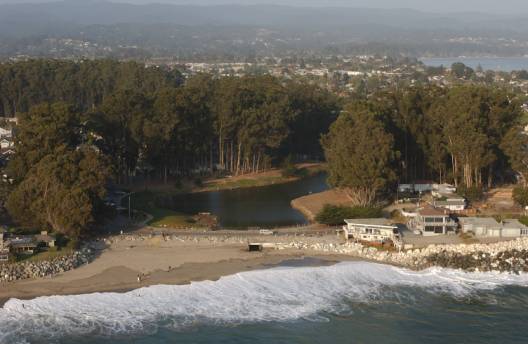
Figure 5.1. Moran Lake Outlet (September, 2002)
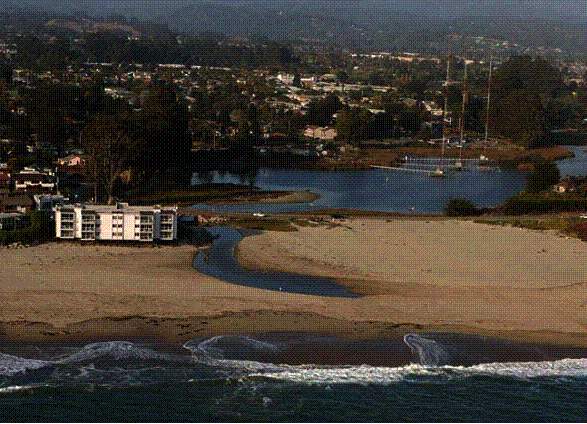
Figure 5.2. Corcoran Lagoon (September 2002)
The potential benefits of modifications to the lagoon inlet include increasing the frequency of lagoon flushing, increasing lagoon volume, and improving water quality within the lagoon.
Replacing the box culvert with an arched bottomless culvert or clear span bridge would not impede the lagoon inlet to a fixed depth, which may increase tidal flushing and the frequency of lagoon opening and closing.Figure 5.3 presents examples of a bottomless arched culvert used to restore stream and lagoon functions in sensitive habitat areas.However, limited beach profiling information collected during the period of study suggest that the inlet configuration at Moran Lake may function similar to an unimpaired lagoon system, with seasonal fluctuations of the ephemeral bar on the Moran Lake beach controlling the connection of the lagoon with the ocean.
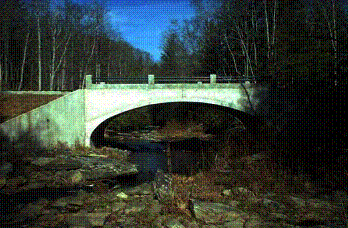
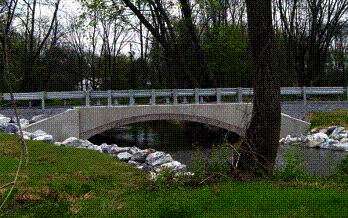
Figure 5.3. Examples of Bottomless Arched Culvert Crossings
Replacing the box culvert with a new culvert or clear span bridge could modify the lagoon substantially.During wet years, flood flows could cause the lagoon inlet channel to scour and lower, and/or storm surges and wave action combined with high flows could result in more extensive bank erosion, as compared to what has been experienced in recent years.This change could result in further bank instability and erosion and possible damage to public and private properties. A change in the culvert size or invert elevation could also increase lagoon salinity affecting sensitive species such as tidewater goby and monarch butterfly. Further analysis would be required to more thoroughly assess the potential benefits and impacts associated with a modification of the existing culvert.
Enlarge and Deepen the Lagoon
Enlarging and deepening the lagoon to the original size and configuration is not considered feasible at this time due to the extent of surrounding development and existence of sensitive species’ habitat.Reshaping and enlarging the lagoon would require dredging and be a major undertaking. The water quality benefits achieved are unknown at this time.Federal, state and local permits would be required, and proper disposal of potentially contaminated dredge spoils must also be considered.
Manage the Lagoon Entrance (Breach the Sand Bar)
A common practice previously implemented at several large lagoons in the Monterey Bay region, included the active breaching of sand bars.This practice was routinely conducted for flood control, primarily to protect private properties in close proximity to a lagoon from becoming inundated when the lagoon water levels rose in winter or late summer.However, in most instances this practice has been curtailed in response to sensitive species issues. Artifically removing sand from the culvert and excavating a drainage channel between the culvert and ocean is a related technique with similar consequences. Actively managing the sand bar would require a thorough, costly and possibly lengthy environmental review process to obtain and maintain permits to undertake the activities. Artificial breaching could lead to greater ocean- lagoon water exchange, however, the water quality benefit achieved by this action is unknown at this time.
Install an Aeration System
Similar to a wastewater treatment system, an aeration system could be installed in the lagoon to improve water quality.The aeration system would be designed to maintain high dissolved oxygen levels and improve mixing throughout the lagoon and water column. This management option may have some water quality and biologic benefits, but a more detailed water quality evaluation and design analysis would be required to determine the size and the capital, operation and maintenance costs of an aeration system for the lagoon.
Stream Flow Augmentation with Highly Treated Reclaimed Wastewater
Presently, freshwater flows to the lagoon are intermittent, with high flows during the winter months and very low or no flows during the summer.Stream flow augmentation using highly treated reclaimed wastewater, if it were to become available from the County Sanitation District, could be a method to maintain higher water quality in the lagoon.A small satellite wastewater treatment system could be constructed at the Lode Street facility (R. Lather, personal communication 2004). Introducing higher freshwater flows during the dry period would lower the salinity and increase the water level in the lagoon.However, at this time public sentiment may not support this project, and proceeding with this option would require a thorough, lengthy environmental, permitting, public review and education process.
5.1.2 Create Wetlands in Upper Lagoon
Historical fill practices have significantly impacted Moran Lake by diminishing over forty percent of the surface area of the lagoon.This has reduced the volume and depth of the lagoon, which has affected the lagoons ability to assimilate or dilute pollutants entering the lagoon during winter runoff events.Expanding the effective surface area of the lagoon would be beneficial.However, increasing the lagoon area is constrained by development, competing land uses and sensitive species protection (monarch butterfly habitat).
A potential opportunity to create an expanded wetland on public lands within the upper lagoon has been identified.Wetlands have been shown to be effective filters of urban stormwater pollutants, and could reduce the concentration of nutrients, solids, metals and other constituents entering Moran Lake.Figure 5.4 shows County owned land that may be suitable for development of a wetland.
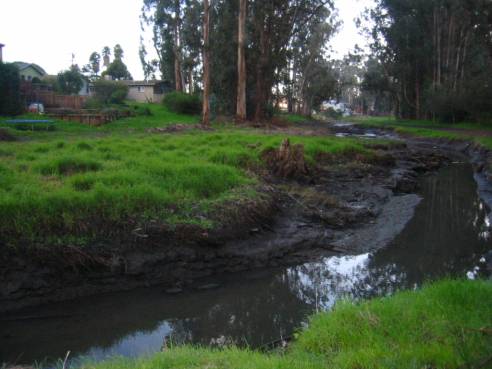
Figure 5.4.Public Land in Upper Lagoon Identified for Possible Wetland
A wetland in the upper lagoon could potentially improve water quality and improve wildlife foraging and nesting habitat within the lagoon.Construction of a wetland would also develop more natural hydrologic conditions within the lagoon by restoring a wetland area where it likely existed historically.Figures 5.5 and 5.6 present a conceptual layout and cross section of how a wetland in the upper lagoon could be constructed.The wetland could incorporate walking trails for public access, as well as multiple pools with varying depths to maximize pollutant removal and habitat diversity.
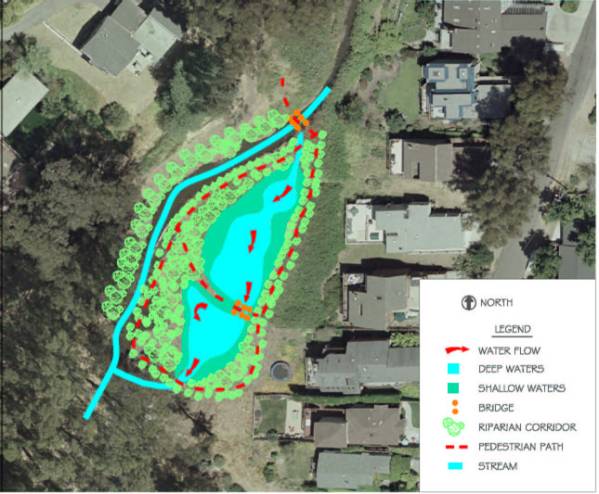
Figure 5.5.Conceptual Layout of Proposed Wetland in the Upper Lagoon Area of Moran Lake
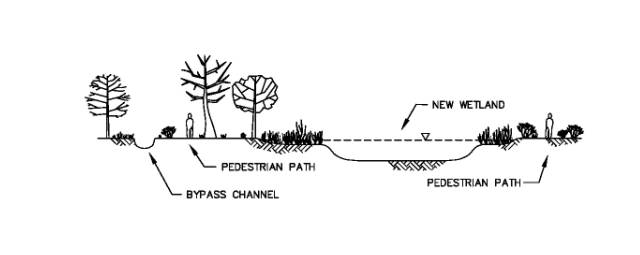
Figure
5.6. Cross-Section of Restored Wetland Area
The appropriate wetland depths, configuration, mix of wetland plant species, inlet and outlet structures need to be considered in final design of this facility. Future investigation into the creation of wetlands in the upper lagoon should consider the issue of mosquito abatement, particularly the public health issues associated with West Nile Virus, and the proper management of the wetland during high and low flow periods.This alternative would also require a significant environmental and public review process.
5.1.3 Reshape Bank Slopes and Restore Lagoon Fringe Wetlands
Due to urban development adjacent to the lake wetlands that once likely existed along the edges of Moran Lake have been destroyed.Concurrent with the removal or alteration of fringe wetlands, diminished vegetation and increased flows from a mostly impervious watershed have resulted in failing banks at some locations along the shore of the lagoon. The most notable failure has occurred on the lower east lagoon bankslope. Figure 5.7 shows the failing bank and its proximity to a frequently accessed bike trail.(A portion of the slope near the lagoon outlet has been reinforced with riprap.)
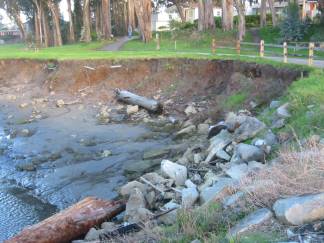
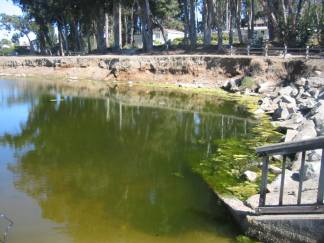
Figure 5.7.Eroding
Bank on the Eastern Shore of Moran Lake
(Photos taken on September 11, 2003 (lower) and February 2,
2004)
Undertaking a bank stabilization project is important to protect the bicycle path and to reduce further erosion.A bank stabilization project that employs a biotechnical solution, incorporating a combination of vegetation and structural elements, is desirable to restore the bank to a more natural configuration and to restore habitat value to the disturbed area.
conceptual bank stabilization project is proposed utilizing a biotechnical approach to stabilize the bank to protect the bicycle path and improve wetland habitat along the fringe of the lagoon.The conceptual plan would regrade the existing steep bank to a 2.5:1 to 3:1 slope from the crown of the slope and incorporate a low terrace or bench at the toe that can be planted with native brackish wetland species.The upper bank could be planted with salt tolerant upland herb and shrub species with the upland flat planted with scattered trees, herbs, and grasses.This design would have the benefits of creating additional wildlife habitat while reducing or eliminating the current rate of bank erosion. In order to protect the bicycle path and adjacent upland, the restored bank may need to be rebuilt in a westerly direction recapturing the bank lost to erosion. Figure 5.8 is a cross section showing a conceptual design of the restored bank.
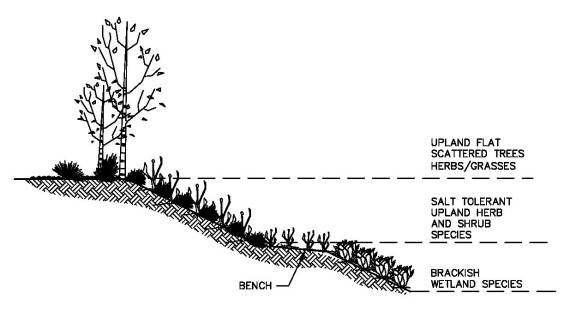
Figure 5.8.Cross-Section showing the Conceptual Layout of Restored Bank on Eastern Shore of Moran Lake
Further engineering analysis of this project may indicate the need to incorporate some additional structural protection (such as a crib type wall to reduce the slope of the bank) or hardscape (such as riprap at the toe of the bank to protect the toe of the bank from excessive scour) combined with the vegetative treatment.
5.1.4 Remove Non-Native Plants and Restore with Native Wetland and Upland Species
Many of the native plants that once lined the banks, shores and upland areas adjacent to Moran Lake have been removed, disturbed, or replaced with non-native species.The highly invasive exotics are of the most concern. To restore the lagoon and upland habitats to a more natural condition, removal of non-native plants and replacement with native wetland and upland species is recommended. Removal of non-native species along Moran Lake would eliminate aggressive species that can rapidly spread into adjacent natural areas.Complete elimination of the ice plant, French broom and Himalayan blackberry is recommended.Replacement with natives should follow a detailed revegetation plan that indicates species composition, planting guidelines, irrigation and other maintenance requirements, and a monitoring protocol. Figure 5.9 is one example of an area covered with iceplant (Mesembryanthemum spp.) which could be removed and revegetated with wetland and upland plants that would also provide slope protection. Exotics removal and revegetation should be handled in phases and coupled with erosion control to prevent slope destabilization during implementation. The hands on work of exotics removal and native plant installation would also provide an opportunity to involve volunteers from the Moran Lake community.
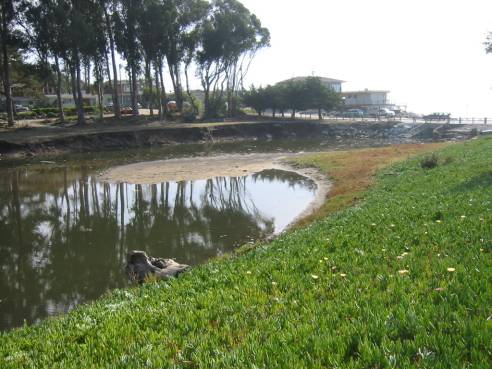
Figure 5.9.Possible
Location for Revegetation with Native Plant Species
(Area presently covered almost exclusively with non-native ice
plant)
The eucalyptus groves within Moran Lake County Park provide critical Monarch butterfly habitat.Therefore elimination of eucalyptus (also somewhat invasive) is not recommended, but management of trees in these areas should follow guidelines contained in the Monarch Management Plan (Janecki et.al. 2002).English ivy and Cape ivy are highly invasive exotics that are growing beneath and up eucalyptus trees.As these species are one of few nectar sources for butterflies during fall and winter months, it is recommended they be retained and controlled only in high density butterfly areas. They should be selectively removed in other locations where they are spreading, and replaced with compatible native or non-invasive ornamental nectar plants.
5.1.5 Interpretive Trail and Signing
The existing trails within the Moran Lake County Park are well used and present an opportunity to develop an interpretive trail and signing.The unique lagoon ecosystem and monarch habitat provide educational themes for community members, visitors, and students.Possible signing themes include: lagoon wetland functions in maintaining/enhancing water quality; wildlife species information, including habitat and species’ life cycles; monarch butterfly habitat, migration, winter roosting, and importance of specific microclimate conditions; and native plant species’ identification and recognition.An example of the type of visual and factual information an interpretative sign could include is shown in Figure 5.10.
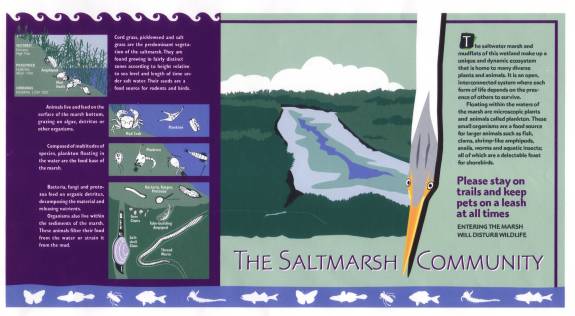
Figure 5.10.Example of Interpretive Sign (S. Erspalmer, Design Science, 2001)
The Monterey Bay Marine Sanctuary has recently placed a sign near the parking lot at Moran Lake County Park, and any future development of interpretive signs in the area should be consistent and compliment this existing sign.In developing the interpretive signs, careful consideration should also be given to protection against vandalism.
5.2. Watershed Restoration
This section presents a series of potential restoration opportunities that may be undertaken in the upper watershed of the lagoon.The primary goals of these projects are to establish better storm water treatment/ filtration systems, restore stream and riparian habitats, create better groundwater recharge, and reduce the need for costly flood control engineering measures.
5.2.1 Water Treatment Wetland at 38th Ave. Detention Basin
The existing storm water detention basin located at 38th could potentially be modified to function as a storm water treatment wetland during low flow events.The existing detention basin could be reconfigured to divert runoff through the wetland during low flow periods. During high flow events the wetland would be temporarily inundated, allowing it to capture nutrients, bacteria and heavy metals contained in urban runoff.The wetland could improve surface water quality entering the lower reaches of Moran Creek and ultimately the lagoon.The wetland could also be designed to provide wildlife habitat.A conceptual layout of how the 38th Avenue detention basin could be reconfigured to a low flow stormwater wetland is presented in Figure 5.11.
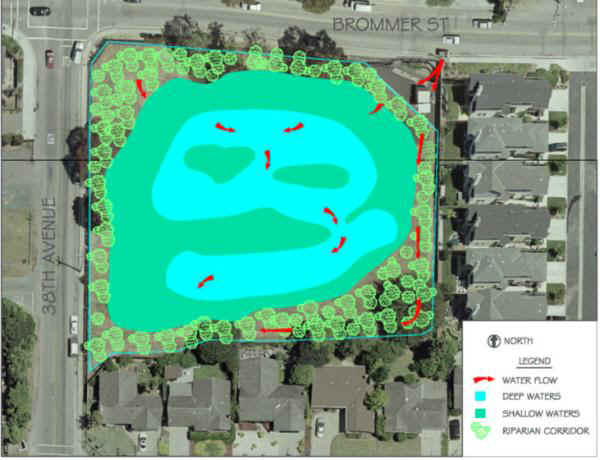
Figure 5.11.Conceptual Layout of 38th Avenue Detention Basin Modified to Include a Stormwater Wetland
Additional engineering and hydrologic analyses are required to develop a detailed conceptual and/or preliminary design of a stormwater wetland in the detention basin.It will be important that the new facility be able to provide an equivalent level of flood control currently provided by the detention basin.Further analysis will also be necessary to evaluate the actual water quality benefits to downstream watercourses provided by a modified basin.
5.2.2. Restore Moran Creek Riparian Corridor
Development in the Moran Lake watershed has significantly reduced the Moran Creek riparian corridor and floodplain.At many locations the Moran Creek channel has been placed in underground culverts. In other areas development has encroached into the riparian corridor eliminating the low flood terrace and riparian vegetation that plays an important role in natural stream function. It would benefit the overall condition of Moran Lake to restore the floodplain and riparian corridor to a more natural function to the extent practicable.Any opportunity to restore undeveloped or redeveloped lands to increase the stream corridor and daylight the stream would be a significant benefit to the watershed.
In areas where a narrow above-ground channel exists, widening of the stream corridor to provide for a functional riparian corridor buffer should be considered. High density development and urbanization severely limit restoration opportunities, and any possible stream restoration will be tied to new land use projects.Figure 5.12presents a conceptual layout and cross section of an above-ground portion of Moran Creek that could be considered for restoration as land use in the area changes.The restoration concept plan suggestswidening and reshaping the stream channel to a more natural meandering flow path.
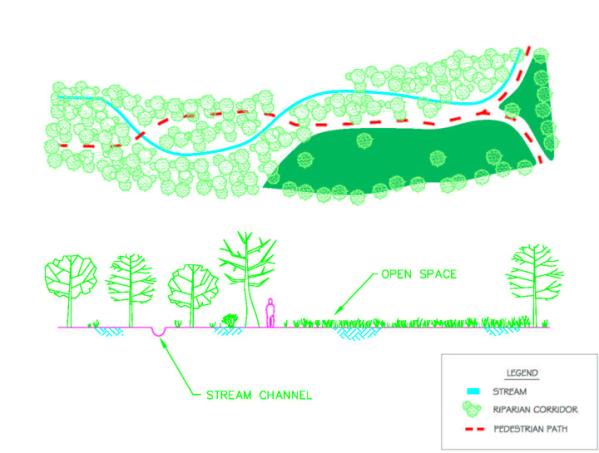
Figure 5.12.Conceptual Layout of Moran Creek Stream Restoration
5.3. Storm Water Management and Treatment
Adopting new storm water control measures are an important step towards reducing the amount of pollutants from urbanized areas in the watershed in order to protect the lagoon and Monterey Bay.Presently, a substantial number of source control and treatment best management practices (BMPs) are available to reduce pollutants (see Appendicies B&C).The following section presents a summary of the available BMPs that can meet a variety of treatment and site restoration goals.Several of the BMPs are landscaped-based techniques, such as bioretention and vegetated swales and constructed wetlands.These types of BMPs can achieve a high level of contaminant reduction, provide for ecologic restoration, and are considered integral to the restoration of water quality in the lagoon.
This section of the report provides a general overview of the type and use of BMPs.The information provided is not intended to be used for design purposes; several other technical resources area available for the site-specific design of BMPs.A list of technical resources is presented in Appendix C.
5.3.1. Innovative Site Design
Considering that many of the future projects in the urbanized areas will require substantial new site development, the opportunity exists to address storm water management at the onset of a project through the site planning and design process.Adopting innovative planning and design approaches that can minimize the volume, speed and quantity of pollutants released from the site will in turn reduce the size of structural BMPs required.
Several factors contribute to storm water degradation in a conventional development.Large paved roads and parking surfaces create and collect runoff.Building sites may be graded substantially, altering runoff patterns and removing natural vegetation that absorbs runoff.The curbs, gutters, and catch basins collect runoff and carry it rapidly, proving little opportunity for treatment or infiltration.Consequently large quantities of runoff may be carried to a conveyance storm water system, discharging sediments and other pollutants directly to the creek, lagoon and Monterey Bay.
Innovative approaches to site design can be incorporated into the planning and development process to reduce the volume and improve the quality of runoff leaving these sites.Innovative site design techniques employ a variety of methods to reduce total paved area, distribute and diffuse storm water, and conserve natural or landscaped areas.The approach seeks to accomplish three goals at every development site: to reduce the amount of impervious cover, to increase landscaped areas or natural areas set aside for conservation and recreation, and to use pervious areas for more effective storm water treatment.To meet these goals designers and planners must scrutinize every aspect of a site plan – its streets, sidewalks, driveways, and parking spaces, to determine if these elements can be incorporated.At the same time creative grading and drainage techniques should be employed to reduce the volume of storm water runoff and direct runoff to natural landscaped areas maximizing site infiltration and passive treatment of pollutants.
5.3.2. Storm Water Control and Treatment BMPs
A variety of storm water control and treatment BMPs can be selected for a site, including source control measures, and structural and non-structural treatment BMPs.Source control measures include a variety of hazardous materials management systems, such as enclosed fuel and hazardous material storage areas, secondary containment measures for fuel, waste oil and other hazardous wastes, street sweeping, and diversion of washwater and other process flows to the County’s sanitary sewer system.Typical structural BMPs include various types of in-line filters and cyclonic separation technology.Non-structural BMPs typically include landscape based natural treatment systems, including bioretention areas, grass swales, constructed wetlands and other passive treatment systems.Appendix B includes an overview of storm water control practices, including source control measures, filtration control measures, and detention type storm water treatment systems.
5.3.3. Performance Standards for Storm Water Management
The greatest opportunity to protect water quality and reduce storm water runoff can occur during site planning and the design phase of any project.Therefore, adopting performance standards or criteria addressing site design standards is a critical element of any storm water management program. Early planning efforts afford the designer the opportunity to identify multi-site conjunctive uses including storm water control measures.Additionally, establishing performance standards for storm water best management practices clarifies the planning, selection and design of the specific BMPs appropriate for the site and related land use activities.New development opportunities in the Moran Lake watershed could provide the County and City of Capitola with an opportunity to adopt alternative site design standards that can reduce impervious surfaces and storm water runoff from these areas. Appendix C outlines typical site design performance standards and design standards for storm water management and treatment best management practices.
5.4. Public Education and Outreach
Development of public education and outreach projects within the Moran Lake watershed would ultimately benefit the lagoon by increasing awareness about lagoon functioning and proper watershed practices.Possible outreach could include informational brochures to community members, interpretive signs, and community activities focused on the stream or lagoon awareness, education and restoration.Simple brochures could be prepared addressing the importance of stream stewardship.For example, maintaining good water quality practices means not using the creek, drainage inlets or lagoon as an urban waste dump. The adverse effects of toxic chemicals on long-term habitat quality and public health should also be emphasized.
Possible community actions include formation of a watershed group through the California Coordinated Resource Management and Planning (CRMP) process, or developing a volunteer water quality monitoring effort through the Coastal Watershed Council (CWC).Outreach could also be accomplished through organization of community members to volunteer for stream cleanup and exotic plant species’ removal.Public and educational workshops about Moran Lake would also help to strengthen a commitment from residents within the Moran Lake watershed to protect and restore the lagoon.Special attention should be given to upper watershed land uses especially commercial uses along 41st Avenue and Portola Drive, and the numerous mobile home parks within watershed.















